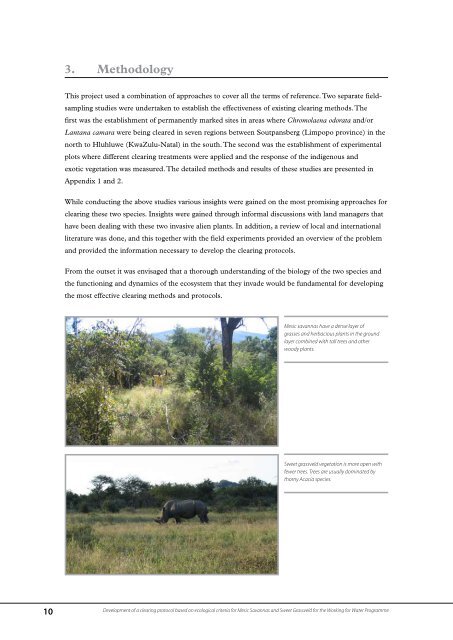Euston-Brown, D., Rathogwa, N & Richardson ... - DWA Home Page
Euston-Brown, D., Rathogwa, N & Richardson ... - DWA Home Page
Euston-Brown, D., Rathogwa, N & Richardson ... - DWA Home Page
Create successful ePaper yourself
Turn your PDF publications into a flip-book with our unique Google optimized e-Paper software.
10<br />
3. Methodology<br />
This project used a combination of approaches to cover all the terms of reference. Two separate field-<br />
sampling studies were undertaken to establish the effectiveness of existing clearing methods. The<br />
first was the establishment of permanently marked sites in areas where Chromolaena odorata and/or<br />
Lantana camara were being cleared in seven regions between Soutpansberg (Limpopo province) in the<br />
north to Hluhluwe (KwaZulu-Natal) in the south. The second was the establishment of experimental<br />
plots where different clearing treatments were applied and the response of the indigenous and<br />
exotic vegetation was measured. The detailed methods and results of these studies are presented in<br />
Appendix 1 and 2.<br />
While conducting the above studies various insights were gained on the most promising approaches for<br />
clearing these two species. Insights were gained through informal discussions with land managers that<br />
have been dealing with these two invasive alien plants. In addition, a review of local and international<br />
literature was done, and this together with the field experiments provided an overview of the problem<br />
and provided the information necessary to develop the clearing protocols.<br />
From the outset it was envisaged that a thorough understanding of the biology of the two species and<br />
the functioning and dynamics of the ecosystem that they invade would be fundamental for developing<br />
the most effective clearing methods and protocols.<br />
Mesic savannas have a dense layer of<br />
grasses and herbacious plants in the ground<br />
layer combined with tall trees and other<br />
woody plants.<br />
Sweet grassveld vegetation is more open with<br />
fewer trees. Trees are usually dominated by<br />
thorny Acacia species.<br />
Development of a clearing protocol based on ecological criteria for Mesic Savannas and Sweet Grassveld for the Working for Water Programme
















